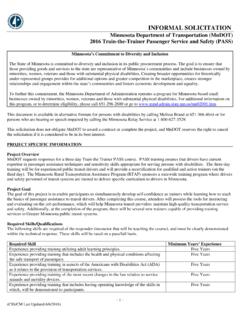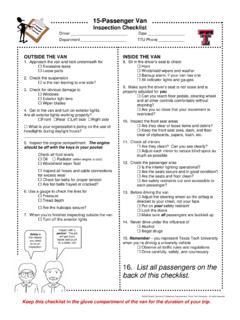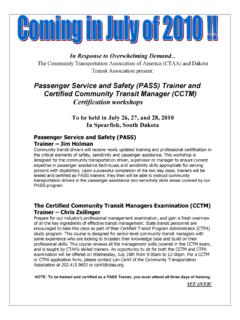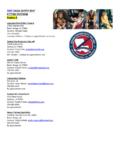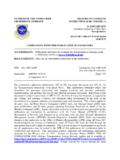Transcription of Passenger Service SICS A B PASS
1 1 Passenger Service and SafetyASICSHow to properly assist and interact with your passengers Developed by Community Transportation Association of America1 PASS BADISCLAIMERThe PASS Basic Training Manual and Power Point Presentation is for the use of participants in the CTAA PASS Basic Program. It is offered only for information purposes. It is not intended to be all inclusive or to address ppthe hazards faced by each participant specifically. The manual specifically does not address issues or duties arising out of any Federal, State or local statutes, ordinance or regulations, except in a direct manner. Users must evaluate their own needs and adapt the information and procedures in this manual to meet those needs. CTAA assumes no liability for the contents herein or lack by Community Transportation Association of America2 PASS Basics Segment # 1In this segment we will cover:You as a professionalCustomer ServiceCommunicationStress ManagementDeveloped by Community Transportation Association of America32 YOU AS A PROFESSIONAL Developed by Community Transportation Association of America4 CHARACTERISTICS OF A PROFESSIONALEach trained for a to have special to meet licensing a valuable serviceDeveloped by Community Transportation Association of America5 The Final characteristic of a professional is high level performance at all s easy to be positive feel good and treat others well It s easy to be positive, feel good, and treat others well when everything is fine.
2 The difficulty comes when things are NOTgoing well. This is the true test of your skill as a by Community Transportation Association of America3 When being pleasant to passengers is not easy, try following one or more of these techniques: Refocus think about positive things in order to stop thinking about negative things Talk it out talk with other operators and supervisors Understand If there is a problem, contribute to the solution as best you can7 Developed by Community Transportation Association of AmericaA professional driver must possess the necessary skills to work with passengers, family of passengers, agency administrators, a motor vehicle safely is not enough. You must also;also; Make the Passenger feel welcome Answer questions8 Developed by Community Transportation Association of America Make the ride safe and comfortable Handle any problems that occurFll il ii Follow special instructions Keep accurate and timely records of your work9 Developed by Community Transportation Association of America4 Passengers rightfully expect safe, efficient and comfortable transportation time to permit passengers to board and exit ftbl d b ti t id it t h comfortably and, be certain to provide assistance to each by Community Transportation Association of AmericaPractically everything done while performing your job and the manner in which you conduct yourself while performing it.
3 Contributes either favorably or unfavorably to the Passenger s image of you and your unfavorably to the Passenger s image of you and your by Community Transportation Association of AmericaKEEP IN MIND:Good performance is taken for granted poor performance is always by Community Transportation Association of America5 Support and explain agency policies when dealing with passengers. Speak positively about your agency. Avoid talking about how tough your job Talk over agency/organization problems with supervisors NOT by Community Transportation Association of AmericaThree basic rules or skills that you must know and safe, reliable and expert Service Drive safely and smoothly at all times Speak clearly, calmly and with respect Offer assistance to every passenger14 Developed by Community Transportation Association of AmericaBe courteous and patient Use respectful language and tone of voice Leave your troubles at home or with arguments Remain polite Do not get angry15 Developed by Community Transportation Association of America6 When you perform your job as a professional, everyone benefit because your passengers will.
4 T ll Treat you more pleasantly Willingly follow your directions Respect you as a professional16 Developed by Community Transportation Association of AmericaYour passengers benefit through: Safe, comfortable and reliable transportationYour agency benefits because you help to: Increase supportive ridership Improve community support and potential funding Reduce insured risks17 Developed by Community Transportation Association of AmericaCUSTOMER SERVICE18 Developed by Community Transportation Association of America7 The driver is the most important asset of a transit agency. However, the most important person at the transit agency is the customer. Without the customer, th i there is no by Community Transportation Association of AmericaWho are your customers?Think in terms of who receives the Service and how that Service impacts that individual or group.
5 Also, think about who provides the Service and how the perceptions of employees, funders, contributors and perceptions of employees, funders, contributors and taxpayers have a strong positive or negative effect on your by Community Transportation Association of AmericaGroups to consider as customers include: Potential riders these individuals are not using your Service now, but may in the future Existing riders these are the people for whom your Service exists21 Developed by Community Transportation Association of America8 Former riders these individuals were users of your Service , which made a difference in their lives; either positive or negative Indirect customers those not using, but influenced or affected by your Service , , employer or family of a person you transport22 Developed by Community Transportation Association of America Funders of Service this can include funding agencies, state or federal departments of transportation, Service clubs, municipalities and individual community members and elected officialsindividual community members and elected officials Co workers In a transit agency, every employee is a customer to at least one other by Community Transportation Association of AmericaOf all the things you do as a transportation vehicle operator.
6 The way you interact with your passengers will have the most influence on your job and the future will have the most influence on your job and the future of your by Community Transportation Association of America9 Consider these facts: As a driver, you represent your employer In the course of a day, you have more contact with the public than any other employee of your agencythe public than any other employee of your agency A large number of motorists and pedestrians see your vehicle25 Developed by Community Transportation Association of AmericaA Passenger should never have to ask for assistance because the driver failed to offer it. As a driver, you are responsible for Passenger safety . Therefore, assistance must be offered to every Passenger , every day. You are responsible for assisting passengers in and out of the by Community Transportation Association of AmericaSome riders may wish to board or exit the vehicle on their own.
7 Be close by to assist these individuals should it be needed If injury occurs as a result of should it be needed. If injury occurs as a result of negligence because a driver failed to get out of the driver s seat, you, the driver, may be found at by Community Transportation Association of America10 Helping passengers get on and off the vehicles requires some judgment calls from the driver. It may be safer, and faster, to request the Passenger use a boarding wheelchair and the lift. In accordance with the ADA, if a boarding wheelchair is not available, the Passenger may stand on the liftmay stand on the by Community Transportation Association of AmericaWhen providing assistance, it is very important to remember you are dealing with a before taking direct is extremely important and must remain a high priority.
8 Therefore, if a Passenger refuses your offer of assistance, you must be close by and watch for signs of by Community Transportation Association of AmericaHandling customer ( Passenger ) complaints Listen non defensively, no matter how outrageous the complaint may seem, listen without bias or judgment Validate the feelings of the person making the Validate the feelings of the person making the complaint. Acknowledge the frustration and confirm their right to feel upset30 Developed by Community Transportation Association of America11 Remember, feelings are not always rational, but are real don t make promises or try to solve the problem in the heat of the moment Try to see the problem from their point of viewDo you know what your company policy is concerning complaints?
9 31 Developed by Community Transportation Association of AmericaCOMMUNICATION32 Developed by Community Transportation Association of AmericaCommunication is a series of obstacles and are in a position to control whether those obstacles become problems, or whether you can find the opening for effective communication which can help opening for effective communication, which can help toward solving problems and make you and those around you feel by Community Transportation Association of America12To understand your Passenger s point of view, put yourself in their place. Treat others as you would want to be treated or how you would want a transportation to be treated, or how you would want a transportation vehicle operator to treat a member of your by Community Transportation Association of AmericaEmotional communication is more likely to get out of control.
10 Make a determined effort to stay or frustration is caused by any number of reasons, including personal problems, traffic, schedule, unfriendliness, etc. Anxiety will limit an operator s capacity to be tolerant and by Community Transportation Association of AmericaThree steps for better alert to the person be an active how you communicate Use simpler wordshhdhhlld Show how to do the things you are telling to do Write it down or draw a simple picture You may need to give the information more than for comprehension Ask the Passenger what they are going to do now36 Developed by Community Transportation Association of America13 Tips on communicating with passengers Treat adults as adults Offer assistance ASK Speak directly to the Passenger If you do not understand the Passenger do not pretend that you did37 Developed by Community Transportation Association of AmericaSTRESS38 Developed by Community







